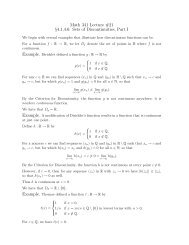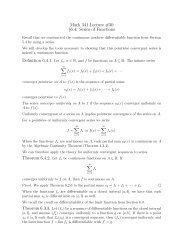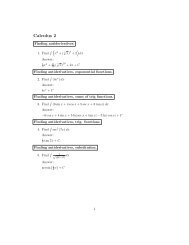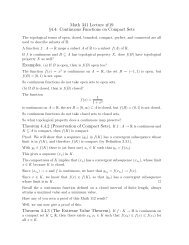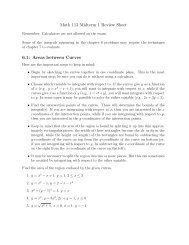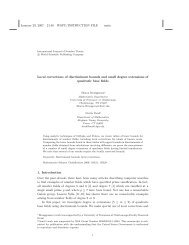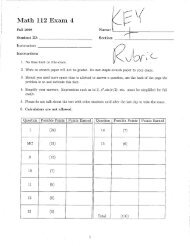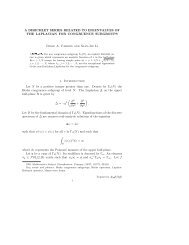Create successful ePaper yourself
Turn your PDF publications into a flip-book with our unique Google optimized e-Paper software.
8.5. THE ESTIMATION OF EIGENVALUES 83We now consider the situation that A (t) is an n×n matrix and that t → A (t) is continuous for t ∈ [0, 1] .Lemma 8.12 Let λ (t) ∈ σ (A (t)) for t < 1 and let Σ t = ∪ s≥t σ (A (s)) . Also let K t be the connectedcomponent of λ (t) in Σ t . Then there exists η > 0 such that K t ∩ σ (A (s)) ≠ ∅ for all s ∈ [t, t + η] .Proof: Denote by D (λ (t) , δ) the disc centered at λ (t) having radius δ > 0, with other occurrences ofthis notation being defined similarly. ThusD (λ (t) , δ) ≡ {z ∈ C : |λ (t) − z| ≤ δ} .Suppose δ > 0 is small enough that λ (t) is the only element of σ (A (t)) contained in D (λ (t) , δ) and thatp A(t) has no zeroes on the boundary of this disc. Then by continuity, and the above discussion and theoremwe can say there exists η > 0, t + η < 1, such that for s ∈ [t, t + η] , p A(s) also has no zeroes on the boundaryof this disc and that A (s) has the same number of eigenvalues, counted according to multiplicity, in the discas A (t) . Thus σ (A (s)) ∩ D (λ (t) , δ) ≠ ∅ for all s ∈ [t, t + η] . Now letH =⋃s∈[t,t+η]σ (A (s)) ∩ D (λ (t) , δ) .We will show H is connected. Suppose not. Then H = P ∪ Q where P, Q are separated and λ (t) ∈ P. Lets 0 ≡ inf {s : λ (s) ∈ Q for some λ (s) ∈ σ (A (s))} .We know there exists λ (s 0 ) ∈ σ (A (s 0 )) ∩ D (λ (t) , δ) . If λ (s 0 ) /∈ Q, then from the above discussion thereareλ (s) ∈ σ (A (s)) ∩ Qfor s > s 0 arbitrarily close to λ (s 0 ) . Therefore, λ (s 0 ) ∈ Q which shows that s 0 > t because λ (t) is the onlyelement of σ (A (t)) in D (λ (t) , δ) and λ (t) ∈ P. Now let s n ↑ s 0 . We know λ (s n ) ∈ P for anyλ (s n ) ∈ σ (A (s n )) ∩ D (λ (t) , δ)and we also know from the above discussion that for some choice of s n → s 0 , we have λ (s n ) → λ (s 0 ) whichcontradicts P and Q separated and nonempty. Since P is nonempty, this shows Q = ∅. Therefore, H isconnected as claimed. But K t ⊇ H and so K t ∩ σ (A (s)) ≠ ∅ for all s ∈ [t, t + η] . This proves the lemma.Now we are ready to prove the theorem we need.Theorem 8.13 Suppose A (t) is an n × n matrix and that t → A (t) is continuous for t ∈ [0, 1] . Letλ (0) ∈ σ (A (0)) and define Σ ≡ ∪ t∈[0,1] σ (A (t)) . Let K λ(0) = K 0 denote the connected component of λ (0)in Σ. Then K 0 ∩ σ (A (t)) ≠ ∅ for all t ∈ [0, 1] .Proof: Let S ≡ {t ∈ [0, 1] : K 0 ∩ σ (A (s)) ≠ ∅ for all s ∈ [0, t]} . Then 0 ∈ S. Let t 0 = sup (S) . Sayσ (A (t 0 )) = λ 1 (t 0 ) , · · ·, λ r (t 0 ) . We claim at least one of these is a limit point of K 0 and consequentlymust be in K 0 which will show that S has a last point. Why is this claim true? Let s n ↑ t 0 so s n ∈ S.Now let the discs, D (λ i (t 0 ) , δ) , i = 1, · · ·, r be disjoint with p A(t0) having no zeroes on γ i the boundaryof D (λ i (t 0 ) , δ) . Then for n large enough we know from Theorem 8.6 and the discussion following it thatσ (A (s n )) is contained in ∪ r i=1 D (λ i (t 0 ) , δ). It follows that K 0 ∩ (σ (A (t 0 )) + D (0, δ)) ≠ ∅ for all δ smallenough. This requires at least one of the λ i (t 0 ) to be in K 0 . Therefore, t 0 ∈ S and S has a last point.Now by Lemma 8.12, if t 0 < 1, then K 0 ∪K t would be a strictly larger connected set containing λ (0) . (Thereason this would be strictly larger is that K 0 ∩ σ (A (s)) = ∅ for some s ∈ (t, t + η) while K t ∩ σ (A (s)) ≠ ∅for all s ∈ [t, t + η].) Therefore, t 0 = 1 and this proves the theorem.Now we can prove the following interesting corollary of the Gerschgorin theorem.





